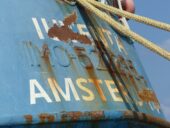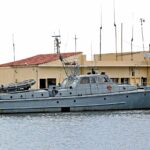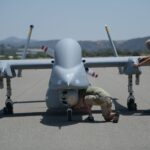After a ten-month break, the “Seabird 2” is back over the central Mediterranean. With this aircraft, the pilots detect sea emergencies and notify nearby ships for rescue.
The sea rescue organisation Sea-Watch has resumed its aerial reconnaissance over the central Mediterranean. “Our crew left early in the morning for a flight that hadn’t happened like this since March 2022”, the organisation wrote on the short message service Twitter. After an “unlawful” blockade, the “Seabird 2” took to the air again on Tuesday, they say. Sea-Watch wants to use the aircraft to detect sea emergencies from above and pass on the coordinates to ships in the vicinity.
Ten months ago, Libya had banned Sea-Watch from staying above its search and rescue zone. From 5 March, the aviation authority in Tripoli required pilots to apply for permission to fly beforehand.
This violates international law, admitted by the German government, among others, in the summer. The demand for a permit for flights outside the state’s territory was “contrary to the principle of freedom of overflight on the high seas”, according to the Federal Ministry of the Interior’s answer to a parlamentarian question by MP Clara Bünger.
Previously, the Scientific Services of the Bundestag had expressed the same opinion in an assessment. The area in question lies outside the twelve-mile zone and is therefore open to civilian aircraft of all states. Therefore, Libyan authorities could not impose restrictions there. Moreover, the central Mediterranean is considered uncontrolled airspace, for which such a notification is not required. At most, the aviation authorities are allowed to give indications and information on air traffic control there.
The “freedom of overflight” is also regulated in the 1944 Chicago Convention, the implementation of which is monitored by the International Civil Aviation Organisation. The United Nations Convention on the Law of the Sea, concluded 38 years later, reaffirms this agreement. Both agreements have been violated by the Libyan government with the flight ban.
Nevertheless, Sea-Watch complied with the order from Tripoli, probably also to avoid reprisals from Italy. The two countries cooperate closely in the fight against migration. With EU funding, Italy authorised the Libyan Coast Guard to control its sea rescue zone in the first place. On Libya’s instructions, the right-wing government in Rome could take action against rescue planes flying from Sicily over the central Mediterranean.
The Sea-Watch aircraft “Seabird 1” and “Seabird 2” are operated by the Humanitarian Pilots Initiative from Switzerland. Because they fly under Swiss flag, the government in Berne would be responsible for diplomatic interventions against the Libyan no-fly zone. As a state party to the International Civil Aviation Organisation, Switzerland could press the United Nations for “freedom of overflight”. However, this has not happened.
According to its own information, however, the German Federal Ministry of the Interior has spoken out to the Libyan government “against restrictive administrative rules”, including those concerning the freedom of overflight. However, the ministry did not say when and on what occasions this took place.
The EU border agency Frontex also began setting up its own aerial surveillance in the central Mediterranean in 2016, which, like Sea-Watch, is mainly deployed over the Libyan sea rescue zone. However, the aircraft leased from European companies were not subject to restrictions from Libya. Since May 2021, Frontex has been flying most of its missions with a drone stationed at the international airport in Malta. Frontex passes on the reconnaissance data to the Libyan coast guard, among others.
“Our blockade was never about a lack of authorisation, but an attempt to stop us from doing our work,” says Felix Weiß from Sea-Watch. Last year alone, the rescue organisation’s aircraft completed 121 missions, sighting 190 boats with over 11 000 people in distress at sea. “There needs to be a civilian eye over the place where so much else goes down,” Weiß tells “nd”.
Published in German in „nd“.
Image: The crew prepares the reconnaissance aircraft “Seabird 1” for the mission (David Lohmueller/ Sea-Watch).





Leave a Reply